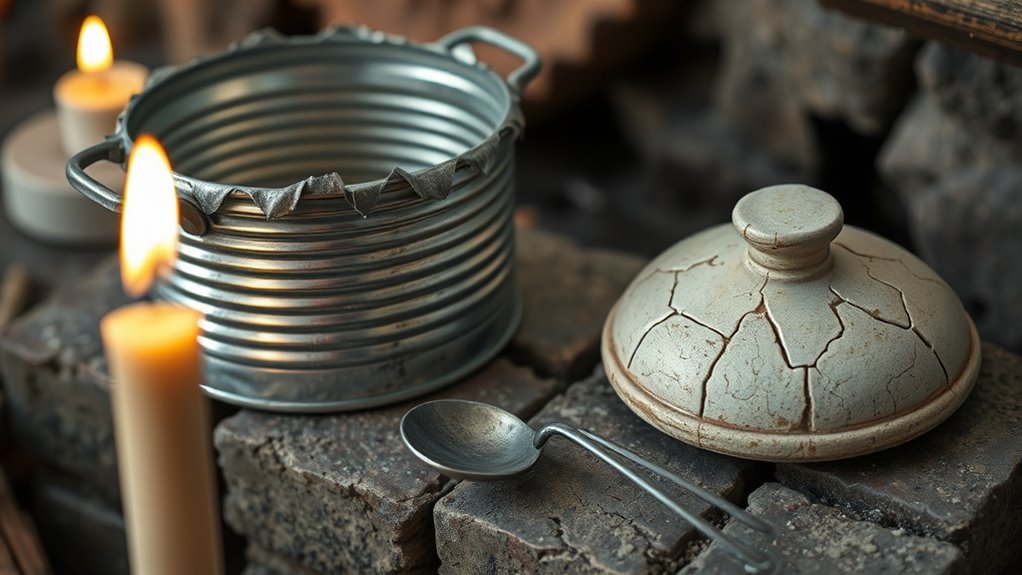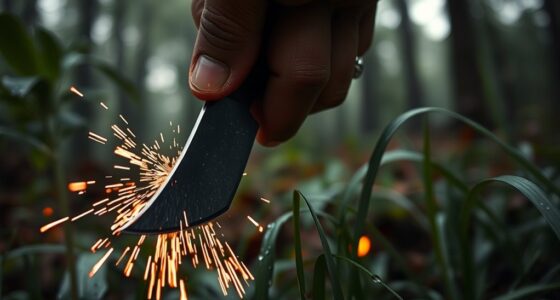To make improvised cooking utensils, gather sturdy household items like metal or wooden spatulas, or repurpose clean plastic or cardboard for lightweight tools. Use sharp edges from broken glass or knives carefully, and mark measurements on containers for accurate cooking. You can also craft safety tools like tongs from sticks or skewers. Guarantee all materials are heat-resistant and safe for food contact. If you continue exploring, you’ll find useful tips to craft effective, safe utensils from common supplies.
Key Takeaways
- Use flat, heat-resistant scrap metal or thick wood for durable spatulas and turners.
- Repurpose household items like spoons, sticks, or plastic utensils as stirring tools.
- Create cutting implements from broken glass or sturdy knives, ensuring edges are smoothed for safety.
- Mark measurement levels on clean containers or use household objects for approximate ingredient measurement.
- Use clean metal or ceramic bowls as temporary cooking vessels, checking heat resistance before use.

When you’re caught in a situation without traditional cooking utensils, improvising can be a lifesaver. Instead of panicking, look around your environment for everyday items you can transform into homemade tools or DIY kitchenware. For example, a sturdy metal or wooden spatula can be fashioned from a flat, rigid piece of scrap metal or a thick piece of wood, carefully smoothed to avoid splinters. You might also repurpose a clean, flat piece of cardboard or plastic as a makeshift spatula or turner, especially if you need something lightweight and non-stick-friendly. Just ensure whatever material you choose is safe for contact with food and can withstand heat.
If you’re in a pinch and need a stirring or mixing tool, consider using clean, long-handled items like a metal or plastic spoon from other household areas. In a pinch, sturdy sticks or skewers can be used as tongs or fork substitutes, especially if you clip or tie smaller items together to create a makeshift gripping tool. For cutting, a sharp edge from a clean, broken glass or a sturdy knife can serve as a makeshift cutter. Just be cautious to avoid jagged edges that could cause injury. Sanding down or wrapping the edges with cloth or tape can help make these tools safer to handle.
In cases where you lack proper measuring cups or spoons, you can create DIY kitchenware by marking a clean container with measurements or using common household items as reference points. For example, a small cup can serve as a rough measure if you know its capacity, or you can use a piece of string to measure out ingredients by length and then transfer them into your cooking vessel. When heating or boiling liquids, a clean metal or ceramic bowl can work as a temporary pot, provided it’s heat-resistant and safe for cooking over your heat source. Always test for stability and safety before placing it over flames or coals.
Frequently Asked Questions
Can Improvised Utensils Be Safely Used for All Types of Cooking?
Improvised utensils can’t be safely used for all types of cooking. You should consider safety concerns, like potential chemical leaching or burns, especially with certain materials. Material limitations also matter—some items may melt, crack, or release harmful substances when exposed to heat. Always evaluate the utensil’s heat resistance and non-toxic properties before using it for cooking, and stick to safer, purpose-made tools whenever possible.
How Do I Clean Improvised Cooking Utensils Effectively?
You should clean improvised cooking utensils thoroughly with cleaning techniques like scrubbing with soap and hot water. Afterward, use proper sanitization methods such as boiling, soaking in a bleach solution, or using alcohol-based sanitizers. Make sure to rinse well and dry completely to prevent bacteria growth. Regular cleaning and sanitization make certain your utensils stay safe for cooking and help avoid contamination.
What Materials Are Safest for Making Improvised Utensils?
You should choose safe materials like food-grade silicone, stainless steel, or bamboo for making improvised utensils. These are non-toxic options that won’t leach harmful chemicals into your food. Avoid plastics with unknown additives or metals that can corrode. Stick to natural, durable, and non-reactive materials to guarantee safety while cooking. Using these safe materials helps prevent contamination and keeps your food healthy.
How Durable Are Homemade Cooking Utensils Compared to Store-Bought Ones?
Your homemade cooking utensils can be surprisingly durable, but they generally don’t match store-bought ones in material strength and long-term durability. While sturdy materials like metal or heat-resistant plastics can withstand regular use, homemade utensils often wear out faster, like a passing breeze. They’re perfect for quick tasks, but for everyday cooking, investing in commercial tools guarantees you get utensils that last through countless meals.
Are There Any Risks Associated With Using Improvised Cooking Tools?
Using improvised cooking tools can pose risks, especially regarding food safety and material hazards. You might accidentally introduce harmful substances if the materials aren’t food-grade or if they contain toxins. There’s also a chance of contamination or breakage, which could cause injury or spoil your food. Always verify your tools are made from safe, non-toxic materials and are sturdy enough to handle cooking tasks to minimize these risks.
Conclusion
Now, with simple materials, you turn everyday objects into lifesaving tools, showcasing your resourcefulness. It’s inspiring to see how something as basic as a broken spoon or a piece of scrap metal can become a cooking utensil, reminding us that innovation often springs from necessity. In a world where comfort and survival intertwine, your ingenuity transforms despair into hope, proving that even in tough times, a little creativity can cook up solutions that nourish more than just your body—it feeds your spirit.









